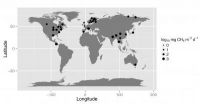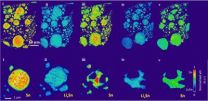(Press-News.org) This news release is available in German.
With DESY's X-ray light source PETRA III, Danish scientists observed the growth of nanoparticles live. The study shows how tungsten oxide nanoparticles are forming from solution. These particles are used for example for smart windows, which become opaque at the flick of a switch, and they are also used in particular solar cells. The team around lead author Dr. Dipankar Saha from Århus University present their observations in the scientific journal Angewandte Chemie – International Edition.
For their investigation, the scientists built a small reaction chamber, which is transparent for X-rays. "We use fine capillaries of sapphire or fused silica which are easily penetrable by X-rays," said Professor Bo Iversen, head of the research group. In these capillaries, the scientists transformed so-called ammonium metatungstate dissolved in water into nanoparticles at high temperature and high pressure. With the brilliant PETRA III X-ray light, the chemists were able to track the growth of small tungsten trioxide particles (WO3) with a typical size of about ten nanometres from the solution in real time.
"The X-ray measurements show the building blocks of the material," said co-author Dr. Ann-Christin Dippel from DESY, scientist at beamline P02.1, where the experiments were carried out. "With our method, we are able to observe the structure of the material at atomic length scale. What is special here is the possibility of following the dynamics of the growth process," Dippel points out. "The different crystal structures that form in these nanoparticles are already known. But now we can track in real-time the transformation mechanism of molecules to nanocrystals. We do not only see the sequence of the process but also why specific structures form."
On the molecular level, the basic units of many metal-oxygen compounds like oxides are octahedra, which consist of eight equal triangles. These octahedra may share corners or edges. Depending on their configuration, the resulting compounds have different characteristics. This is not only true for tungsten trioxide but is basically applicable to other materials.
The octahedra units in the solutions grow up to nanoparticles, with a ten nanometre small particle including about 25 octahedra. "We were able to determine that at first, both structure elements exist in the original material, the connection by corners and by edges," said Saha. "In the course of the reaction, the octahedra rearrange: the longer you wait, the more the edge connection disappears and the connection by corners becomes more frequent. The nanoparticles which developed in our investigations have a predominantly ordered crystal structure."
In the continuous industrial synthesis, this process occurs so quickly, that it mainly produces nanoparticles with mixed disordered structures. "Ordered structures are produced when nanoparticles get enough time to rearrange," said Saha. "We can use these observations for example to make available nanoparticles with special features. This method is also applicable to other nanoparticles."
INFORMATION:
Deutsches Elektronen-Synchrotron DESY is the leading German accelerator centre and one of the leading in the world. DESY is a member of the Helmholtz Association and receives its funding from the German Federal Ministry of Education and Research (BMBF) (90 percent) and the German federal states of Hamburg and Brandenburg (10 percent). At its locations in Hamburg and Zeuthen near Berlin, DESY develops, builds and operates large particle accelerators, and uses them to investigate the structure of matter. DESY's combination of photon science and particle physics is unique in Europe.
Original publication
"In Situ Total X-Ray Scattering Study of WO3 Nanoparticle Formation under Hydrothermal Conditions"; D. Saha et al.; Angewandte Chemie - International Edition (Vol. 53, No. 14, 1 April 2014); DOI: 10.1002/anie.201311254 (online publication on 26 February 2014)
Scientists watch nanoparticles grow
Analysis allows tailoring materials for switchable windows and solar cells
2014-03-27
ELSE PRESS RELEASES FROM THIS DATE:
Record quantum entanglement of multiple dimensions
2014-03-27
The states in which elementary particles, such as photons, can be found have properties which are beyond common sense. Superpositions are produced, such as the possibility of being in two places at once, which defies intuition. In addition, when two particles are entangled a connection is generated: measuring the state of one (whether they are in one place or another, or spinning one way or another, for example) affects the state of the other particle instantly, no matter how far away from each other they are.
Scientists have spent years combining both properties to construct ...
A more potent greenhouse gas than CO2, methane emissions will leap as Earth warms
2014-03-27
While carbon dioxide is typically painted as the bad boy of greenhouse gases, methane is roughly 30 times more potent as a heat-trapping gas. New research in the journal Nature indicates that for each degree that the Earth's temperature rises, the amount of methane entering the atmosphere from microorganisms dwelling in lake sediment and freshwater wetlands — the primary sources of the gas — will increase several times. As temperatures rise, the relative increase of methane emissions will outpace that of carbon dioxide from these sources, the researchers report.
The findings ...
Researchers reveal the dynamics behind Arctic ecosystems
2014-03-27
Field studies covering three continents show that temperature has an unexpectedly important effect on food-web structure, while the relationship between predator and prey is crucial for the food-web dynamics and thereby the entire ecosystem.
Temperature is decisive
'We have gathered data on all animals and plants characterising the arctic tundra in seven different areas. This has allowed us to generate a picture of how food chains vary over a very large geographical (and, with it, climatic) gradient. Therefore, and for the first time, we can offer an explanation of ...
IRCM researchers uncover a new function for an important player in the immune response
2014-03-27
Montréal, March 27, 2014 – IRCM researchers led by Javier M. Di Noia, PhD, uncovered a new function of AID, a crucial enzyme for the immune response. The discovery, recently published by the scientific journal Proceedings of the National Academy of Sciences (PNAS), helps explain a rare genetic disorder that causes an immunodeficiency syndrome.
The Montréal research team studies the enzyme AID, or activation-induced deaminase, that can be found in B lymphocytes (the group of white blood cells whose main function is to produce antibodies to fight against infections). AID ...
Scientists track 3-D nanoscale changes in rechargeable battery material during operation
2014-03-27
UPTON, NY-Scientists at the U.S. Department of Energy's Brookhaven National Laboratory have made the first 3D observations of how the structure of a lithium-ion battery anode evolves at the nanoscale in a real battery cell as it discharges and recharges. The details of this research, described in a paper published in Angewandte Chemie, could point to new ways to engineer battery materials to increase the capacity and lifetime of rechargeable batteries.
"This work offers a direct way to look inside the electrochemical reaction of batteries at the nanoscale to better understand ...
Dentist shortage bites California as more choose to practice out of state
2014-03-27
A lingering recession, the elimination of Medicaid dental reimbursements and a glut of established dentists in wealthier, populated areas may explain why more new dentists are practicing outside California, according to a new policy brief from the UCLA Center for Health Policy Research.
"Good access to dental care depends on having a robust supply of new dentists in California," said Nadereh Pourat, director of research at the center and lead author of the study. "We need a new generation of dentists to replace the many dentists who are close to retirement." ...
Decline of natural history troubling for science, society
2014-03-27
Support for natural history – the study of organisms, how and where they live and how they interact with their environment – appears to be in steep decline in developed countries, according to Joshua Tewksbury, a University of Washington professor and WWF International scientist.
"Yet natural history provides essential knowledge for fields as varied as human health, food security, conservation, land management and recreation," he said.
Tewksbury and 16 other scientists from across North America outline the importance to society and call for a revitalization of the practice ...
Big data keeps complex production running smoothly
2014-03-27
Large amounts of data are produced when industrial companies monitor their facilities. Sensors check temperature, pressure, power, or energy use data. "If you're scanning to the nearest second, it's easy to rack up several terabytes of information in under a week," says Dr. Olaf Sauer from the automation business unit at the IOSB. But often there is a lack of suitable methods to evaluate the information. "Today's operators use only about seven percent of this data for maintenance or protection from breakdowns," adds Sauer. At the Hannover Messe Digital Factory, IOSB developers ...
One size does not fit all: Dietary guidelines for choline may be insufficient
2014-03-27
What is now considered to be the "right" amount of the essential nutrient, choline, might actually be "wrong," depending on who you are. That's because scientists have found that the "right" amount of choline needed by an individual is influenced by a wide range of factors, including gender, life stage, race and ethnicity of the individual. This means that using the current one-size-fits-all approach to determining a person's vitamin and mineral needs may leave them in less than optimal health. Choline is an essential nutrient used by the body to construct cell membranes ...
First sightings of solar flare phenomena confirm 3D models of space weather
2014-03-27
Scientists have for the first time witnessed the mechanism behind explosive energy releases in the Sun's atmosphere, confirming new theories about how solar flares are created.
New footage put together by an international team led by University of Cambridge researchers shows how entangled magnetic field lines looping from the Sun's surface slip around each other and lead to an eruption 35 times the size of the Earth and an explosive release of magnetic energy into space.
The discoveries of a gigantic energy build-up bring us a step closer to predicting when and where ...
LAST 30 PRESS RELEASES:
Interaction of climate change and human activity and its impact on plant diversity in Qinghai-Tibet plateau
From addressing uncertainty to national strategy: an interpretation of Professor Lim Siong Guan’s views
Clinical trials on AI language model use in digestive healthcare
Scientists improve robotic visual–inertial trajectory localization accuracy using cross-modal interaction and selection techniques
Correlation between cancer cachexia and immune-related adverse events in HCC
Human adipose tissue: a new source for functional organoids
Metro lines double as freight highways during off-peak hours, Beijing study shows
Biomedical functions and applications of nanomaterials in tumor diagnosis and treatment: perspectives from ophthalmic oncology
3D imaging unveils how passivation improves perovskite solar cell performance
Enriching framework Al sites in 8-membered rings of Cu-SSZ-39 zeolite to enhance low-temperature ammonia selective catalytic reduction performance
AI-powered RNA drug development: a new frontier in therapeutics
Decoupling the HOR enhancement on PtRu: Dynamically matching interfacial water to reaction coordinates
Sulfur isn’t poisonous when it synergistically acts with phosphine in olefins hydroformylation
URI researchers uncover molecular mechanisms behind speciation in corals
Chitin based carbon aerogel offers a cleaner way to store thermal energy
Tracing hidden sources of nitrate pollution in rapidly changing rural urban landscapes
Viruses on plastic pollution may quietly accelerate the spread of antibiotic resistance
Three UH Rainbow Babies & Children’s faculty elected to prestigious American Pediatric Society
Tunnel resilience models unveiled to aid post-earthquake recovery
Satellite communication systems: the future of 5G/6G connectivity
Space computing power networks: a new frontier for satellite technologies
Experiments advance potential of protein that makes hydrogen sulfide as a therapeutic target for Alzheimer’s disease
Examining private equity’s role in fertility care
Current Molecular Pharmacology achieves a landmark: real-time CiteScore advances to 7.2
Skeletal muscle epigenetic clocks developed using postmortem tissue from an Asian population
Estimating unemployment rates with social media data
Climate policies can backfire by eroding “green” values, study finds
Too much screen time too soon? A*STAR study links infant screen exposure to brain changes and teen anxiety
Global psychiatry mourns Professor Dan Stein, visionary who transformed mental health science across Africa and beyond
KIST develops eco-friendly palladium recovery technology to safeguard resource security
[Press-News.org] Scientists watch nanoparticles growAnalysis allows tailoring materials for switchable windows and solar cells





